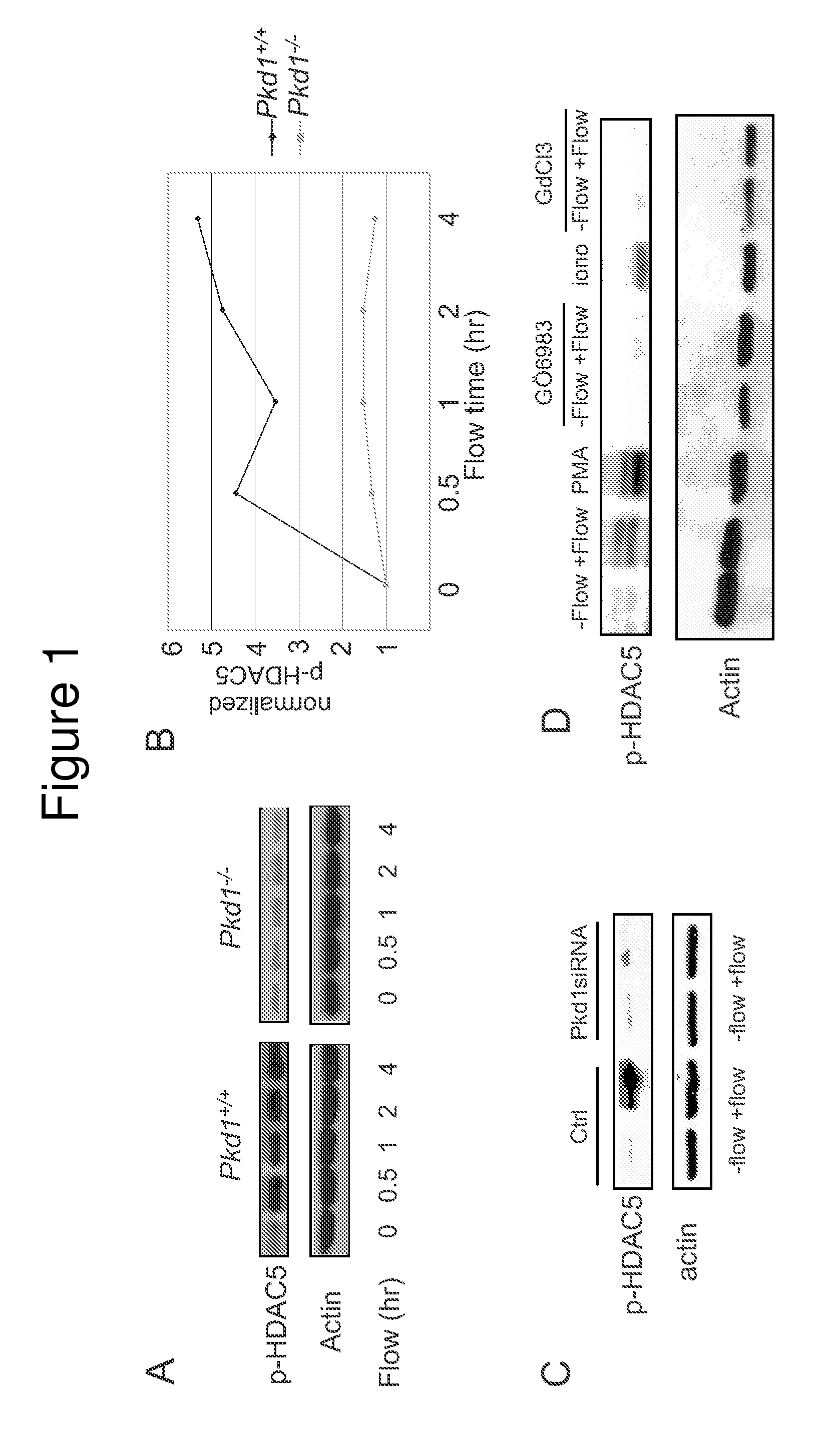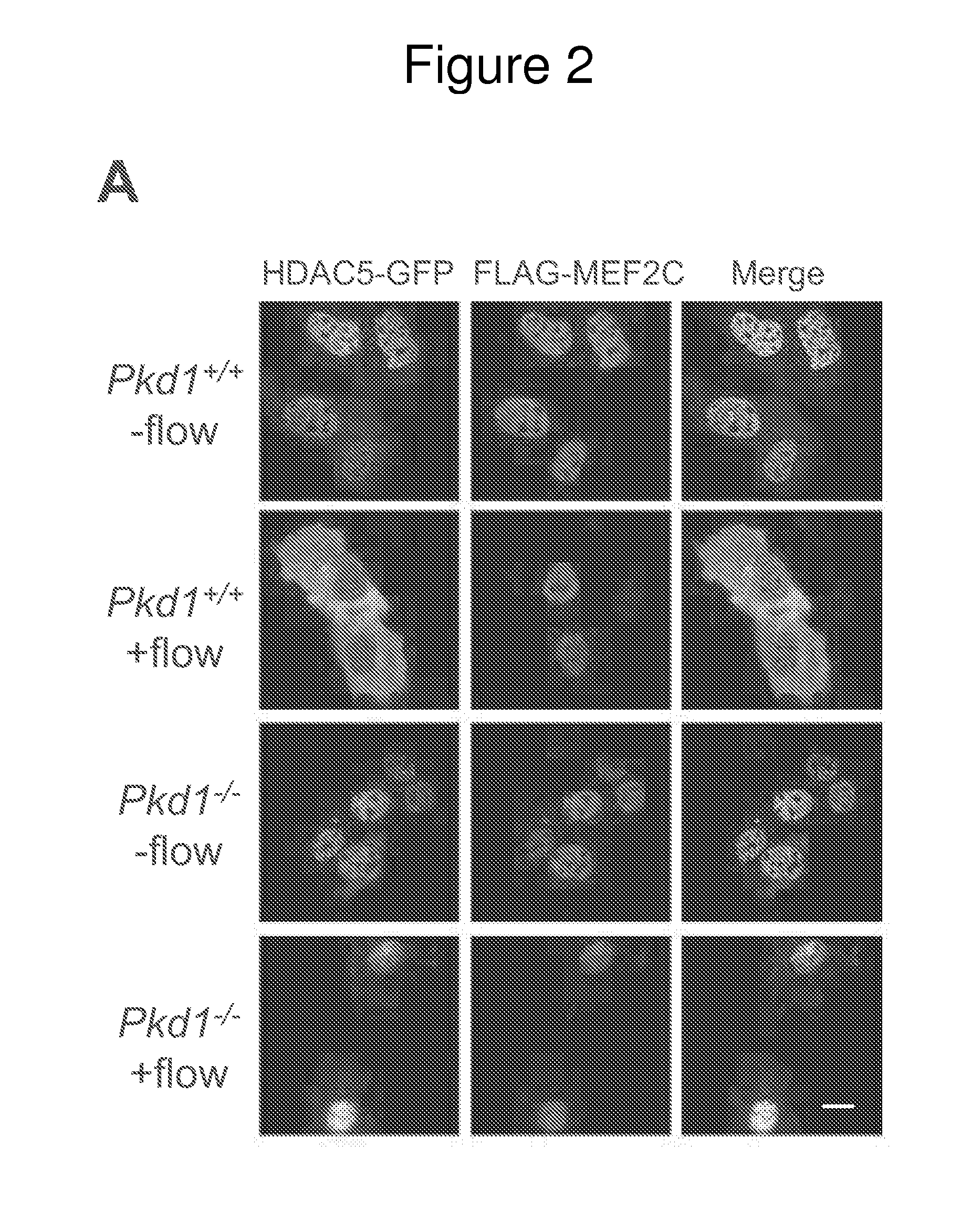Methods for treating polycystic kidney disease (PKD) or other cyst forming diseases
a polycystic kidney disease and other cyst forming diseases technology, applied in the field of treatment and/or amelioration of the effects can solve the problems of renal stones, kidney stones, pain, cyst infection and hemorrhage, etc., and cast doubt on the loss of mechanosensory function mediated by the primary cilia, so as to improve the effect of pkd and related conditions
- Summary
- Abstract
- Description
- Claims
- Application Information
AI Technical Summary
Benefits of technology
Problems solved by technology
Method used
Image
Examples
example 1
Antibodies
[0121]HDAC5 (Phospho-Ser498 human) antibody was obtained from Signalway Antibody (Pearland, Tex.). The non-phosphospecific anti-HDAC5 antibody and anti-MIM antibodies were purchased from Cell Signaling Technologies, Inc. (Denvers, Mass.). Anti-MEF2C antibody was from Santa Cruz Biotechnology, Inc. (Santa Cruz, Calif.). Anti-PC-1 antibody was a generous gift from Patricia Wilson (Wisconsin Medical College). Specific bands detected by the anti-HDAC5, anti-MIM, or anti-PC-1 antibody were verified against null adult kidneys or cell line (FIG. 8).
Fluid Flow Experiments
[0122]Confluent mouse embryonic kidney (MEK) cells were cultured for 1-2 additional days in the absence of interferon-γ to induce optimal differentiation (Nauli et al., 2003). Hanks' Balanced Salt Solution with 20.0 mM HEPES buffer (pH 7.4) and 1% bovine serum albumin was used for calcium imaging and cell culture media for the other experiments. Fluid flow was applied at 0.2 ml / min using a peristaltic pump in 35 m...
example 2
Transcriptional Profiling to Identify Potential Targets of PC-1-Dependent Mechanosenation
[0134]In order to identify pathways downstream of polycystins and the calcium signal in response to fluid shear stress, an in vitro system where fluid was applied using a peristaltic pump at a flow rate of 0.2 ml / min was established. The flow rate correlates to an average flow rate of 30 μm / sec, or a calculated shear stress of 0.020 dyn / cm2, across polarized mono-layers of kidney epithelial cells grown on collagen coated coverslips in 35 mm culture dishes or 6-well plates (FIGS. 9A and 9B). This rate is within the range of flow rates observed in renal tubules and in line with previous work examining the effect of fluid flow on calcium channel activation in epithelial cells (Praetorius and Spring, 2001). To monitor calcium fluxes, GCAMP-2, a genetically coded calcium sensor that produces high signal to noise at physiological calcium concentrations, was used (Nakai et al., 2001; Tallini et al., 20...
example 3
Fluid Flow Induces Hdac5 Phosphorylation, Nuclear Export and MEF2C Target Genes
[0136]The presence of histone deacetylase-5 (HDAC5) and myocyte enhancer factor-2C (MEF2C) among the PC-1-dependent, flow-induced genes was particularly intriguing (see Table 2 above), because these proteins were known to function in the same pathway in the control of cardiac hypertrophy in response to stress and calcium channel activation (McKinsey et al., 2002; Olson et al., 2006). MEF2 targets include not only structural proteins important for cardiac muscle differentiation, but also members of the MEF2 and class II HDAC families through positive feedback loops (Haberland et al., 2007; Wang et al., 2001). Based on the knowledge set forth above, it is reasoned that the presence of both MEF2C and HDAC5 among the fluid flow-induced genes could be a reflection of activation of MEF2-based transcription downstream of the calcium rise elicited by polycystins.
[0137]A well-known post-translational mechanism for...
PUM
| Property | Measurement | Unit |
|---|---|---|
| thick | aaaaa | aaaaa |
| diameter | aaaaa | aaaaa |
| molecular weight | aaaaa | aaaaa |
Abstract
Description
Claims
Application Information
 Login to View More
Login to View More - R&D
- Intellectual Property
- Life Sciences
- Materials
- Tech Scout
- Unparalleled Data Quality
- Higher Quality Content
- 60% Fewer Hallucinations
Browse by: Latest US Patents, China's latest patents, Technical Efficacy Thesaurus, Application Domain, Technology Topic, Popular Technical Reports.
© 2025 PatSnap. All rights reserved.Legal|Privacy policy|Modern Slavery Act Transparency Statement|Sitemap|About US| Contact US: help@patsnap.com



